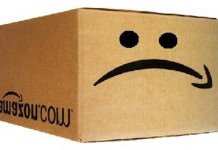 There’s been a lot of speculation over the years about what Amazon might do with physical stores. Using them as boutiques to sell things you can buy on-line has been a favorite prediction, as has using them as a package pick-up point the way Best Buy and Wal-Mart do. And might Amazon use them to push its own self-publishing imprints, which it can’t get into rival Barnes & Noble or many independent bookstores? Oddly enough, Amazon has just opened its first such store and none of those predictions has come true—at least, not exactly.
There’s been a lot of speculation over the years about what Amazon might do with physical stores. Using them as boutiques to sell things you can buy on-line has been a favorite prediction, as has using them as a package pick-up point the way Best Buy and Wal-Mart do. And might Amazon use them to push its own self-publishing imprints, which it can’t get into rival Barnes & Noble or many independent bookstores? Oddly enough, Amazon has just opened its first such store and none of those predictions has come true—at least, not exactly.
The Seattle Times has a report on the store, located in space formerly occupied by a sushi restaurant in an upscale mall in Seattle. (This seems fitting, given that sushi restaurants were unheard-of away from the coastal regions twenty or thirty years ago but then metastasized to cover the entire United States. A good omen for the future of Amazon bookstores?) The store is 5,500 square feet, with 2,000 square feet of storage space. As with practically any new project or product Amazon has ever produced, it goes its own way, based on all the data-gathering and number-crunching Amazon has done over the decades. Sometimes these new projects work, like the Kindle—the e-reader that launched the modern e-book market. Other times they flop badly, like the surprisingly-lackluster Fire Phone.
Which way will Amazon’s foray into bookstore space go? It’s too soon to tell yet. But it’s effectively a re-engineered bookstore, taking things Amazon has learned work well on-line and adapting them to a physical space. It keeps its number of titles low, at 5,000 to 6,000. (I had noted that small bookstores might be a way to compete with Amazon, and the fact that Amazon is keeping the number of titles small in its own bookstore seems to prove that point.)
Title selection seems to be based on Amazon’s number-crunching again—Amazon knows what sells, so it can stock its store almost exclusively with best-sellers and avoid the necessity of sending non-selling titles back to the publisher. (Indeed, given that Amazon’s got warehouses in Seattle, it probably wouldn’t have to send them back to the publisher in any case—just back to the warehouse to be sold on-line instead.) There is also a “staff favorites” section, including a book by Jeff Bezos’s wife, and the store also seems willing to stock some low-sales-rank but highly-reviewed reader picks. There is also a section to sell Kindle and Fire products, as might be expected. What there is not, surprisingly enough, is a way to pick up Amazon orders locally. (I would have at least expected them to put Amazon lockers in. But maybe they’ll wait until they know for sure the store is successful first.)
Rather than being shelved spine-out, the books are all shelved face-out—just the way they would be if you browsed them on Amazon’s web site. (In an amusing bit of irony, this means the real-world shelves in Amazon’s bookstore effectively duplicate the face-out bookshelf-style title selection screens from e-book apps in a sort of reverse skeuomorphism. I remember complaining about how unrealistic those book selection screens were when I first encountered them. Guess the joke’s on me.)
The books have title cards that include a quote from a popular review from Amazon, just as browsing Amazon will bring up such reviews if you scroll down. (More reverse skeuomorphism again.) And the titles will be sold in the store at the same price as they’re sold on-line, which isn’t exactly a surprise either given how many physical stores have evolved a policy of price-matching Amazon these days.
In a very real way, this bookstore is an important test of a principle. Can Amazon use all the data it’s built up from selling retail on-line for years and years to sell well in the real world, too? Can it overcome the overhead costs inherent to bricks and mortar with finely-tuned number-crunching? It promises to be an interesting experiment.
Bookstore chains like Barnes & Noble and the defunct Borders were born over decades, and they carry on much the same now as they have for years because a physical establishment can be very hard to change—even as the real world has changed around them. But Amazon is starting with a clean slate, not bound by the tradition of what worked ten or twenty years ago but focusing on what it can make work now. Can it make it work now? I look forward to finding out.
I must admit, I hope it works out well for Amazon, and that they expand to other locations where they have Amazon warehouses conveniently nearby. There are a lot of Amazon warehouses near Indianapolis. As for expanding to places farther away from the warehouses…that’s trickier. It may be that this sort of retail model couldn’t work without a close warehouse. But who knows? Amazon has surprised us before—it may do so again.
(Found via notification from Nate Hoffelder, who also covered this story himself at The Digital Reader. Thanks for the tip-off, Nate!)




























